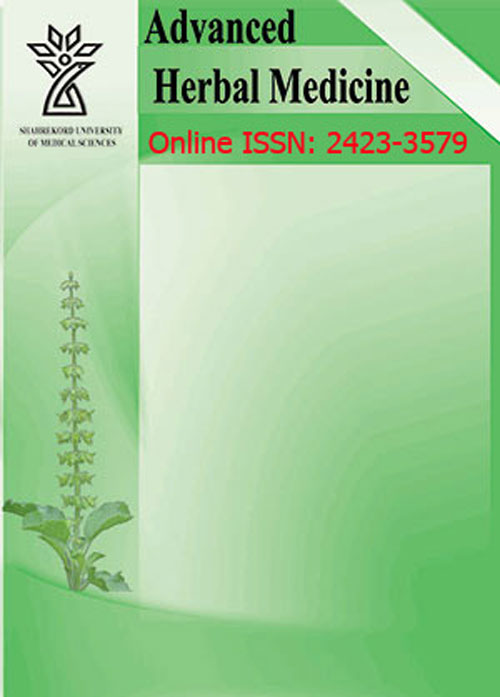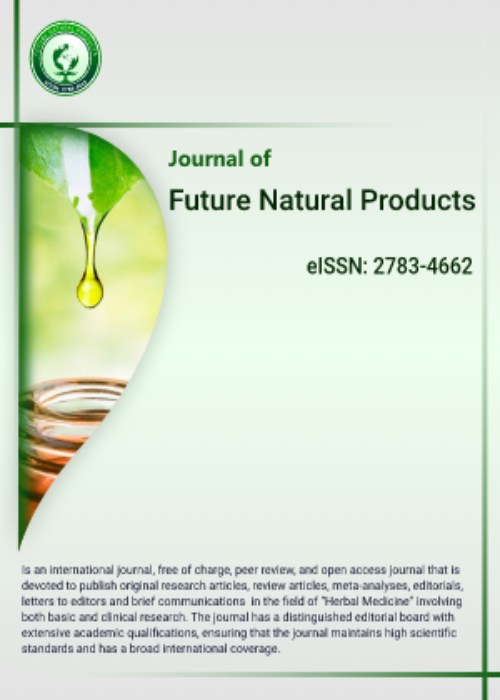فهرست مطالب

Future Natural Products
Volume:2 Issue: 4, Autumn 2016
- تاریخ انتشار: 1395/10/15
- تعداد عناوین: 8
-
Pages 1-6Background And AimsNosocomial infections are common problems in developing and developed countries. One of the pathogens that causes these infections is Pseudomonas aeruginosa. According to the antibiotical resistance of this bacteria, It is essential to find new treatments like new herbal medicine. This study was aimed to determine in vitro antibacterial effects of sesame oil, olive oil and their synergism on P. aeruginosa.MethodsIn this experimental study, first, olive oil and sesame oil were obtained by cold-pressing assay. Then, P.aeruginosa ATCC 27853 was prepared from Iranian Research Organization for Science and Technology. Oils and their mixture with the same proportion were made in concentrations from 2 to 1024 mg/ml and the antibacterial character of these oils on P.aeruginosa was investigated by broth micro dilution method and then the amounts of the MIC and the MBC were demonstrated.ResultsThe MIC of olive oil, sesame oil and their synergism on P.aeruginosa were reported; 16 mg/ml, 128 mg/ml and 128 mg/ml and the MBC of these oils were indicated; 64 mg/ml, 512 mg/ml and 512 mg/ml, respectively.ConclusionThis study showed that sesame oil, olive oil and their synergism can inhibit bacterial growth. Olive oil has more antibacterial effect on this bacteria than sesame oil and their synergism. So, we conclude that there was no synergistic effect in these oils.Keywords: Sesame oil, Olive oil, Synergism, Pseudomonas aeruginosa
-
Pages 7-12Background And AimsEscherichia coli is one of the important bacteria in nosocomial infections and its resistance to a wide range of antibiotics caused many problems for doctors and patients. So, it was attempted to find new substitution for these antibiotics. The aim of the present study was to determine the antimicrobial effect of olive oil, sesame oil and their synergism on E. coli.MethodsIn this study, olive oil and sesame oil were extracted by cold press assay and standard strain of lyophilized E. coli ATCC 25922 was prepared from the Iranian Research Organization for Science and Technology. Olive oil, sesame oil and their synergism, with the same proportion, in concentrations of 2 mg/ml to 1024 mg/ml were made individually and their MBC and MIC amounts were determined by broth micro dilution.ResultsThis study declared MIC and MBC for olive oil; 16 mg/ml and 64 mg/ml, for sesame oil and their mixture; 64 mg/ml and 265mg/ml, respectively.ConclusionThe study showed that both oils and their synergism inhibits the growth of bacteria and the antibacterial properties of sesame oil is approximately equal to the mixture of olive oil and sesame oil and although the oils have good antibacterial effect, there was no synergetic effect in these oils.Keywords: Escherichia coli, Olive oil, Sesame oil, Synergism
-
Pages 13-21Background And AimsUrinary tract infection is considered as one of the most common clinical problems in the world. The aim of this study was to investigate the interaction effects of pharmaceutical and antibacterial activity of methanol extracts of Callistemon viminalis on a number of bacteria that cause urinary tract infections.MethodsIn this experimental research, after drying leaves, extracts were prepared using methanol. The minimum lethal activity of 500, 250 and 125 µg/ml concentrations of the extracts on the standard bacteria was tested using disk diffusion and dilution method. In order to study the synergistic and antagonistic effect, a standard strains of bacteria was cultured on the medium containing methanol extract and then antibiotic discs were put on it.ResultsAccording to the results of disk diffusion test in Agar, the highest inhibition zone diameter in 500 µg/ml was related to Staphylococcus epidermidis and the minimum diameter in this concentration was related to E. coli. Study MIC results was showed that the extract of Callistemon viminalis has the highest inhibitory effect on Staphylococcus saprophyticus and epidermidis. The extracts of Callistemon viminalis showed synergistic effects with vancomycine and ciprofloxacin on Staphylococcus aureus and epidermidis, Proteus vulgaris and Klebsiella pneumoniae.ConclusionThe results of this study indicate that extracts of Callistemon viminalis , alone or in combination with antibacterial agents may be useful in treatment of urinary tract infections. Additionally, this component can enhance the effect of some antibiotics; this implies its application, especially in drug resistance cases.Keywords: Callistemon viminalis, Methanol extract, Antibacterial, Urinary tract infection, Disk diffusion
-
Pages 22-28Background And AimsZea mays L. (Poaceae) husk extract is used traditionally in Ibibio traditional medicine for the treatment of various diseases such as malaria, pains, inflammatory diseases and central nervous system disorders.MethodsThe husk extract (187-748 mg/kg) was evaluated for antidepressant activity in mice using open field, force swimming and tail suspension tests. Determination of median lethal dose (LD50) and phytochemical screening of the husk extract were also carried out using standard methods.ResultsThe husk extract increased significantly the line crossing, walling and rearing activities of mice in open field test (PConclusionThe husk extract of Z. mays has prominent antidepressant activity which is due to the activities of its phytochemical constituents such as phenolic compounds.Keywords: Antidepressant, Zea mays, CNS stimulant
-
Pages 29-34Background And AimsDisease causing bacteria have always been considered a major cause of morbidity and mortality in humans. The appearance of resistant microorganisms paved the way to the occurrence of infections that are only treated by a limited number of antimicrobial agents. The present study was, the antimicrobial effects of Rosmarinus officinalis and Glycyrrhiza glabra extract against some pathogens.MethodsIn this study, the antibacterial activity using 9 Gram-positive and Gram-negative bacterial strains includes: Streptococcus pyogenes ATCC® 19615, Streptococcus pneumoniae ATCC 49619, S. saprophyticus ATCC®15305, Hafnia alvei ATCC 51873, Acinetobacter baumannii ATCC 19606, Enterococcus faecalis ATCC 29212, Proteus mirabilis ATCC 35659, Serratia marcescens ATCC 274 and Staphylococcus aureus ATCC® 25923 with micro dilution methods was studied. The MIC, MBC were studied also, resistance of these bacteria to standard antibiotics such as erythromycin, cefixime, ceftazidime, tetracycline, ampicillin and amikacin were compared.ResultsIn this study, the minimum inhibitory concentration (MIC) was used. The levels of MIC of R. officinalis were in ranges from 6.25 to 25 mg/ml. The highest MIC value was observed at 25 ppm against S. pyogenes, S. pneumoniae and P. mirabilis and the levels of MIC of G. glabra were in ranges from 6.25 to 12.5 ppm. The highest MIC value was observed at 12.5 ppm against S. pyogenes, S. pneumoniae, P. mirabilis and S. marcescens.ConclusionIn important human pathogens, drug resistance is increasing according to the results of this study, and may be proposed that this plant can be used as a drug. It can be a good way to replace herbs with chemical drugs.Keywords: Antibacterial activity, Human pathogen, Minimum inhibitory concentration
-
Pages 35-41Background And AimsIn recent years, the wide usage of herbal drugs has encouraged the medical scientists to evaluate its effects on health. Nigella sativa L. seed (N. sativa) as an herbal drug has prescribed in some diseases such as hyperlipidemia and metabolic syndrome. This study was conducted to investigate the effects of N. sativa on weight, BMI (Body Mass Index) and FBS (Fasting Blood Sugar) in overweight men.MethodsIn this randomized controlled trial, we enrolled seventy eight subjects in two groups to receive 2.5 mL N. sativa oil (n=37) or 2.5 mL paraffin oil as placebo (n=30) two times a day orally for 2 months. FBS, weight, height, and WC (Waist Circumference) of subjects were measured before and after intervention in both groups.ResultsAfter intervention, in N. sativa group, weight, BMI, FBS, and WC were significantly reduced (PConclusionOur results showed that daily intake of 5ml N. sativa oil for two months could significantly reduce weight, WC and FBS in over weight men.Keywords: Nigella sativa, Overweight, Fasting Blood Sugar, Body Mass Index, Waist Circumference
-
Pages 42-51Background And AimsThe main objective of this study was to investigate the factors affecting the achievement of the competitive advantage in the international markets for medicinal plants and related products in Zagros forests.MethodsThis is an applied descriptive/correlational research, because in addition to describing the current situation, its tests hypotheses are based on multiple regression method and determines the impact of variables using the inferential statistics method. In addition, it is an applied research since its expected results can be used to improve the international market of medicinal plants and related products in the Zagros forests. The study population included all customers of medicinal plants and related products in Zagros forests. Considering the fact that the population size is unlimited and undefined, the sample size formula was used. The method used in this research is the cluster sampling and available non-probability sampling. Initially, the Zone was divided into four parts: north, south, east and west. Then, the questionnaires were distributed. The sample size was calculated as 384 people utilizing sample size formula for unlimited population. In this research, the variables of interest were measured using researcher made questionnaires which were distributed among selected subjects whose views will be assessed on the variables. Finally, the collected data was analyzed using SPSS software.ResultsThe results showed that medicinal plants, diversity of medicinal plants, and industrialization of medicinal plants and production of the most essential drugs even certain drugs would lead to the achievement of competitive advantage in the international market of medicinal plants and related products in the Zagros forests.ConclusionPaving the way for investment in the country will make great contribution to the export of medicinal plants products.Keywords: Medicinal plants, competitive advantage, Industrialization, Diversity of medicinal plants
-
Pages 52-59Background And AimsInfectious diseases are among the most important causes of mortality around the world and according to the WHO report 10.5 million cases of death were happened due to infections. Staphylococcus aureus is one of the most important pathogen that its infections are varied from local infections to life threatening infections. With regard to high antibiotic resistance of this agent its control and treatment is a challenge in medicine. The aim of this study was to review the effective medicinal plants against S. aureus with special attention of native plants of Iran.MethodsA comprehensive literature review was performed on papers that have been published from 2004 till 2016 in data resources such as NCBI, Sciencedirect, Springer, Web of science and as well as local databases such as Irandoc, Islamic science citation (ISC) and magiran with special focus on those that have been reported native medicinal plants in Iran. The selected keywords were Staphylococcus aureus, medicinal plant, natural antibiotic, antibacterial plant and medicinal herbs.ResultsDifferent studies were found that have reported effective medicinal plants against S. aureus and were able to significantly inhibit bacterial growth. As well as different parts of these plants have been investigated for antibacterial activity and found that considerable differences are present among these parts of plants.ConclusionBased on the reported studies, there are different medicinal plants in Iran that can be regarded as effective source for discovery new antibacterial agents against
S. aureus and treatment of resistant strains.Keywords: Staphylococcus aureus, Antibiotic resistance, Medical plants


